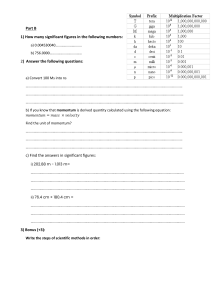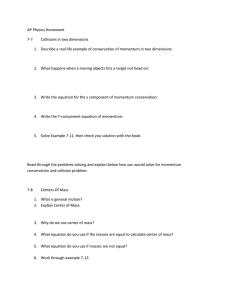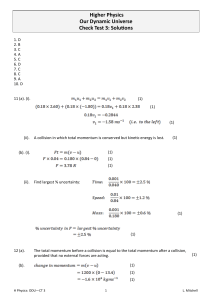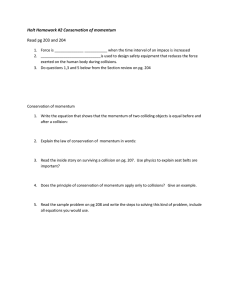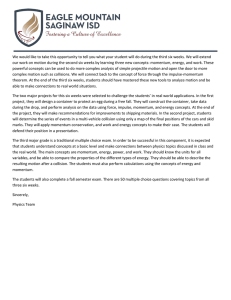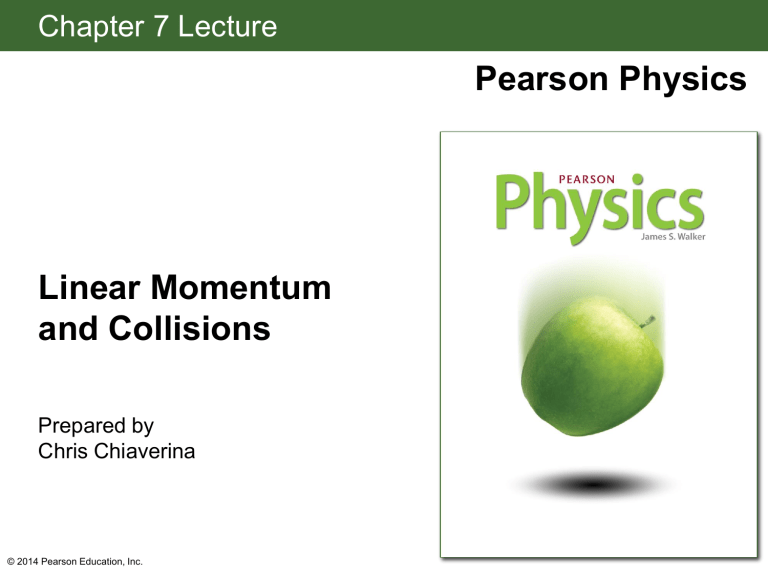
Chapter 7 Lecture Pearson Physics Linear Momentum and Collisions Prepared by Chris Chiaverina © 2014 Pearson Education, Inc. Chapter Contents • Momentum • Impulse • Conservation of Momentum • Collisions © 2014 Pearson Education, Inc. Momentum • How can the effect of catching a slow, heavy object be the same as catching a fast, lightweight object? The answer: They have the same momentum. • Momentum is defined as the mass times the velocity. The symbol for momentum is © 2014 Pearson Education, Inc. © 2014 Pearson Education, Inc. Momentum • Since momentum is the product of mass and velocity, an object's momentum changes whenever its mass or velocity changes. • The units of momentum are kgm/s • is sometimes referred to as the linear momentum to distinguish it from angular momentum, a quantity associated with a rotating object. © 2014 Pearson Education, Inc. Momentum • Momentum is a vector quantity. The momentum vector points in the same direction as the velocity vector. • The following example clearly illustrates why the vector nature of momentum must be taken into account when determining the change in momentum of an object. © 2014 Pearson Education, Inc. Momentum • The figure below shows two objects, a beanbag bear and a rubber ball, each with the same mass and same downward speed just before hitting the floor. • What is the change in momentum of each of the objects? © 2014 Pearson Education, Inc. Momentum • If the beanbag has a mass of 1 kg and is moving downward with a speed of 4 m/s just before coming to rest on the floor, then its change in momentum is • A 1-kg rubber ball with a speed of 4 m/s just before hitting the floor will bounce upward with the same speed. Therefore, the ball's change in momentum is © 2014 Pearson Education, Inc. Momentum • The total momentum of a system of objects is the vector sum of the momentums of all the individual objects: © 2014 Pearson Education, Inc. • Due to the vector nature of momentum, it is possible for a system of several moving objects to have a total momentum that is positive, negative, or zero. © 2014 Pearson Education, Inc. Impulse • The product of a force and the time over which it acts is defined as the impulse © 2014 Pearson Education, Inc. • Because impulse involves the product of force and time, a small force acting over a long time has the same effect as a large force acting over a short time. • The units of impulse are the same as the units of momentum, namely, kgm/s. • Impulse is a vector that points in the same direction as the force. © 2014 Pearson Education, Inc. Impulse • The following example illustrates how impulse is calculated. © 2014 Pearson Education, Inc. © 2014 Pearson Education, Inc. Impulse • As the figure indicates, when a force acts on an object, it changes the object's momentum. • This means there must be a connection between impulse and momentum change. This connection is revealed through the general form of Newton's second law: © 2014 Pearson Education, Inc. Impulse • Rearranging this equation, we get • Therefore, the relationship between the impulse and momentum change is as follows: © 2014 Pearson Education, Inc. © 2014 Pearson Education, Inc. Impulse • The forces associated with impulses are often large and complex. The figure below shows the force exerted on a baseball when struck by a bat. The force acts for as little as a thousandth of a second, during which time it rises to a peak and then falls to zero. • A complex force, such as the one acting on a baseball, may be replaced with an average force. The use of the average force, and the time over which the force acts, facilitates problem solving. © 2014 Pearson Education, Inc. Impulse • Numerous examples of momentumimpulse theorem may be seen in everyday life. © 2014 Pearson Education, Inc. Impulse • A person standing under an umbrella experiences rain, which later turns to hail. Is the force required to hold the umbrella upright in the hail greater than, less than, or equal to the force required to hold it in the rain? • The rain tends to splatter and fall off the umbrella, while the hail tends to bounce back upward. This means that the change in momentum is greater for the hail. Therefore, the impulse and force are greater in the hail. © 2014 Pearson Education, Inc. Impulse • The momentum-impulse theorem shows that increasing the time over which a given impulse acts decreases the average force. Symbolically, • The theorem comes into play in the design of a bicycle helmet. The materials inside a bike safety helmet increase the time of impact, thereby reducing the force—and the extent of injury—to your head. © 2014 Pearson Education, Inc. Conservation of Momentum • The momentum of an object can't change unless an external force acts on the object. • Recall that the impulse is defined as follows: • Based on this definition, if the total force , then the initial and final momentums must be the same, . This is momentum conservation. © 2014 Pearson Education, Inc. Conservation of Momentum • The figure below shows both the internal and external forces acting on a rider and bicycle. • Internal forces, such as a push on the handlebars exerted by a bicycle rider, act between objects within a system. • External forces, such as the force the road exerts on a rear bicycle tire, are exerted on the system by something outside the system. © 2014 Pearson Education, Inc. Conservation of Momentum • Only external forces can change a system's momentum. Internal forces have no effect on a system's momentum. Why is this so? – Internal forces, like all forces, always occur in action-reaction pairs. – Because the forces in action-reaction pairs are equal but opposite, internal forces always sum to zero. That is, – Because internal forces always cancel, the total force acting on a system is equal to the sum of the external forces acting on it: © 2014 Pearson Education, Inc. Conservation of Momentum • Summarizing: – Internal forces have no effect on the total momentum of a system. – If the total external force acting on a system is zero, then the system's total momentum is conserved. That is, • The above statements apply only to the total momentum of the system, not to the momentum of each individual object. © 2014 Pearson Education, Inc. Conservation of Momentum • Momentum conservation applies to all systems, regardless of size. • In a game of billiards, momentum is transferred between the colliding balls, but the total momentum of the interacting balls remains the same. • When you jump into the air, you push off the Earth and the Earth pushes off you. The upward momentum you gain is cancelled by the corresponding downward momentum acquired by the Earth. © 2014 Pearson Education, Inc. Conservation of Momentum • Momentum conservation applies to the largest possible system—the universe. The exploding star in the photo below sends material out in opposite directions, thus ensuring that its total momentum is unchanged. © 2014 Pearson Education, Inc. Conservation of Momentum • Momentum conservation may cause objects to recoil. Recoil is the backward motion caused by two objects pushing off one another. • Recoil occurs when a gun is fired or, as is shown in the figure below, when a firefighter directs a stream of water from a fire hose. • In all cases, recoil is a result of momentum conservation. © 2014 Pearson Education, Inc. Collisions • A collision occurs when two objects free from external forces strike one another. Examples of collisions include one billiard ball hitting another, a baseball bat hitting a ball, and one car smashing into another. • Momentum is conserved when objects collide. However, this does not necessarily mean that kinetic energy is conserved as well. • Collisions are categorized according to what happens to the kinetic energy of the system. © 2014 Pearson Education, Inc. Collisions • A collision in which the kinetic energy is conserved is referred to as an elastic collision. In an elastic collision, the final kinetic energy of the system is equal to its initial kinetic energy. • A collision in which the kinetic energy is not conserved is called an inelastic collision. In an inelastic collision, the final kinetic energy is less than the initial kinetic energy. © 2014 Pearson Education, Inc. Collisions • The figure below shows an example of an essentially elastic collision on the left and an inelastic collision on the right. • An inelastic collision where the colliding objects stick together is referred to as a completely inelastic collision. See the figure below for an example of a completely inelastic collision. © 2014 Pearson Education, Inc. Collisions • Momentum conservation may be applied to find the speed of the two colliding railroad cars in the previous figure after they stick together. © 2014 Pearson Education, Inc. © 2014 Pearson Education, Inc. Collisions • In the previous example, the mass doubles and the speed is halved. Thus, the final kinetic energy is • Therefore, one-half of the initial kinetic energy is converted into other forms of energy such as sound and heat. © 2014 Pearson Education, Inc. Collisions • Most everyday collisions are far from elastic. However, objects that bounce off each other with little deformation—like billiard balls—provide a good approximation to an elastic collision. • The collisions between the metal balls in the figure below are approximately elastic. © 2014 Pearson Education, Inc. Collisions • Elastic collisions are analyzed using both momentum and kinetic energy conservation. • The figure below shows the elastic collision between two air-track carts. • If the masses of the carts are m1 and m2, respectively, then momentum conservation may be expressed as follows: © 2014 Pearson Education, Inc. Collisions • The fact that this is an elastic collision means that the final velocities must also satisfy energy conservation: • Momentum conservation and kinetic energy conservation have provided us with two equations with two unknowns, v1,f and v2,f. Straightforward algebra yields the following results: © 2014 Pearson Education, Inc. Collisions • The final velocity of cart 1 can be positive, negative, or zero, depending on whether m1 is greater than, less than, or equal to m2. The final velocity of cart 2, however, is always positive. The following example illustrates a situation in which the velocity of m1 is reversed. © 2014 Pearson Education, Inc. © 2014 Pearson Education, Inc.
